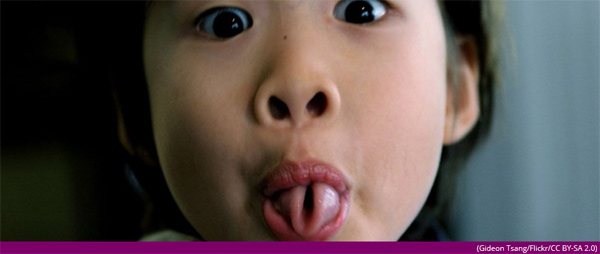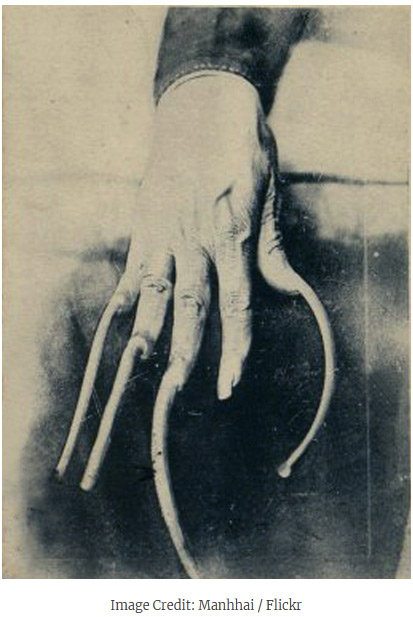当前位置: Language Tips> 双语新闻
6 'facts' about the human body debunked by science
一直以来,我们都认为每个人的指纹都是独一无二的,但事实果真如此吗?以下是我们都坚信的一些关于人体的“事实”,但已经被证实是伪科学。

Myth 1: Your fingerprints are completely unique
误解一:你的指纹是独一无二的
For more than a century, fingerprints have played a major role in forensic investigations. It all started with Scottish scientist and physician Henry Faulds who, in 1888, wrote an article asserting that each person has a wholly unique set of fingerprints.
一个多世纪以来,指纹一直在法医鉴定中发挥着巨大的作用。指纹说源起于苏格兰科学家和医生亨利•福尔兹1888年写的一篇论文,论文中声称每个人都有独一无二的指纹。
Now, a single print in the wrong place can be enough for a criminal conviction. However, we have no way to conclusively prove that each of our collections of whorls, loops, and arches is unique (short of gathering the prints of every person who ever lived and comparing them).
现在,在错误的地方留下一个指纹就足以定罪。但是,我们还无法最终证明我们所收集到的各种指纹(斗型纹、箕型纹、弓型纹)都是独一无二的,更不用说收集和比较那些已经过世的人的指纹了。
"It's impossible to prove that no two are the same," Mike Silverman, a forensic science regulator in the United Kingdom, told The Telegraph. "It's improbable, but so is winning the lottery, and people do that every week."
“没有两个指纹完全一样,这事没法证明,”英国法医监管机构官员迈克•西尔弗曼告诉《每日电讯报》说,“基本不可能,但就和买彩票一样,尽管知道几乎没可能中奖,但还有人每周都买彩票。”
There can be serious consequences if most people believe that fingerprint analysis is infallible. In 2005, Simon Cole, a criminologist at the University of California at Irvine, published a study detailing the 22 known cases of fingerprint mistakes in the history of the American legal system.
如果多数人都相信指纹鉴定绝对不会出错,可能会带来严重的后果。2005年,美国加州大学欧文分校的刑事学家西蒙•科尔发布了一项研究报告,列出了美国司法制度建立以来已知的22个指纹鉴定导致的错误。
He stressed the need to address this misconception lest more innocent people find themselves accused, or even convicted, of crimes they did not commit.
他强调了破除这一误解的必要性,以免更多无辜的人因为指纹被控告,甚至定罪。
Myth 2: Rolling your tongue is a genetic trait
误解二:会卷舌头是基因决定的
In 1940, geneticist Alfred Sturtevant published a paper claiming that genetics determined your ability to roll your tongue - parents who could roll their tongues were likely to have children who could as well.
1940年,遗传学家阿尔弗雷德•斯特蒂文特发表了一篇论文,声称基因决定了你能否卷舌头——能卷舌头的父母会生出能卷舌头的子女。
Just 12 years later, geneticist Philip Matlock disproved this finding with a study of his own. When he compared 33 sets of identical twins, he found that seven of those pairs contained one twin that could roll his or her tongue but the other couldn't.
才过了12年,基因学家菲利普•马特洛克就用自己的研究推翻了这一发现。马特洛克比较33对同卵双胞胎后发现,其中有7对双胞胎一个会卷舌头,另一个不会。
Since the genes of identical twins are the same, genes clearly weren't the deciding factor for tongue rolling. Still, the misconception persists 65 years after Matlock published his debunking study.
既然同卵双胞胎的基因是相同的,基因显然不是能否卷舌头的决定因素。尽管如此,在马特洛克发表了这项颠覆性研究65年之后,仍有人持有这种误解。
And though it's not life-threatening, that misunderstanding can cause unnecessary stress. As evolutionary biologist John McDonald told PBS, he's received emails from children concerned that they aren't related to their parents because they don't share the ability.
尽管这种误解不会危及生命,但还是会带来不必要的压力。进化生物学家约翰•麦克唐纳告诉美国公共广播公司说,他曾收到孩子写来的电子邮件,写信的孩子担心自己不是父母亲生的,因为父母(自己)会卷舌头而自己(父母)不会。
Myth 3: You have five senses
误解三:人有五种感官
Children often learn that they have five senses - sight, hearing, taste, touch, and smell. That's a "fact" that originated in a work by the Greek philosopher Aristotle, written around 350 BC.
通常孩子们学到的知识是,人有五种感官——视觉、听觉、味觉、触觉和嗅觉。这一“事实”源于希腊哲学家亚里士多德于公元前350年左右写的一部作品。
However, you actually have more than five senses. Way more. In fact, scientists aren't even sure just how many more - estimates range from 22 to 33. Some of those other senses include equilibrioception (sense of balance), thermoception (sense of temperature), nociception (sense of pain), and kinaesthesia (sense of movement).
然而,实际上,人的感官不止五种,而是比五种多得多。事实上,科学家甚至都不确定还有多少种感官,据估计有22到33种。其他一些感官包括平衡感、温度感、疼痛感和运动感。
While none of these additional senses include the ability to communicate with the dead, some are absolutely essential for life. For example, our sense of thirst helps our bodies maintain appropriate hydration levels, and people who lack that sense - a rare condition called adipsia - can become severely dehydrated or even die.
尽管其他的这些感官不包括和死人交流的能力,但有些感官对生存至关重要。比如,我们的口渴感觉能帮助身体维持适当的水分,没有口渴感觉的人——这种罕见的病叫渴感缺乏症——可能会严重脱水甚至死掉。

Myth 4: Fingernails and hair continue to grow after death
误解四:指甲和头发在人死后还会继续生长
Our bodies do lots of creepy things after we die, but they don't keep growing our fingernails and hair. To do that, our bodies need to produce new cells - something that simply isn't possible after death.
我们的身体在我们死后还会做很多让人毛骨悚然的事情,但我们的指甲和头发在死后并不会继续生长。如果要继续生长,人体需要制造新细胞,而这在人死后是根本不可能发生的。
This morbid misconception dates back until at least 1929 when writer Erich Remarque immortalised it in his novel All Quiet on the Western Front. In fact, his misunderstanding is due to an optical illusion.
这种病态的误解要追溯到至少1929年,当时作家埃里希•雷马克在他的小说《西线无战事》中让这种观念深入人心。事实上,雷马克的误解源于光学错觉。
While our nails and hair don't continue to grow after we breathe our final breath, our skin does "shrink" as it becomes dehydrated. As the skin retracts, our nails and hair become more exposed, and, thus, they may appear to grow.
在我们断气后,我们的指甲和头发并不会继续生长,但我们的皮肤会因为脱水而收缩。皮肤收缩后,我们的指甲和头发会更多地暴露在外,因此它们看上去就好像继续生长了。
Luckily, getting this one wrong isn't likely to cause much harm - beyond its potential to give children nightmares or exacerbate a person's thanatophobia, of course.
幸运的是,这个误解不会造成太多危害——除了让孩子做噩梦,或加剧人们的死亡恐惧症。
Myth 5: You should never wake a sleepwalker
误解五:你绝对不能叫醒一个梦游的人
Though about 7 percent of the population will sleepwalk at some point in their lives, no one knows for sure what causes somnambulism. What to do should you encounter a slumbering pedestrian is also a source of confusion thanks to a very old misconception.
尽管世界上大约7%的人口会在人生的某个时期梦游,但没人知道是什么原因导致了梦游症。正是因为这个古老的误解,人们搞不清在碰到一个正在梦游的行人时到底应该怎么做。
Mark Pressman, a psychologist and sleep specialist at Lankenau Hospital in Pennsylvania, told Live Science the belief that it's dangerous to wake a sleepwalker began in ancient times when people used to think your soul left your body while you slept.
美国宾夕法尼亚州蓝科纳医院睡眠专家、心理学家马克•普雷斯曼告诉生活科学网站说,认为叫醒梦游者很危险的观念源自于古代,古人认为在你睡觉的时候,你的灵魂会离开你的身体。
Waking a sleepwalker, therefore, would doom the sleeper to a soulless existence. The supposed consequences of waking a sleepwalker have since evolved - some say you could induce a heart attack, or send the sleeper into a permanent state of insanity.
因此,叫醒梦游者会让其变成没有灵魂的人。后来,叫醒梦游者的后果就演变为诱发心脏病或让梦游者从此疯掉。
While Pressman said waking a sleepwalker won't harm them, it might not be easy to do. Letting a sleepwalker's journey continue uninterrupted is clearly not an option since it could have devastating consequences - sleepwalkers have been known to injure themselves or even die in their zombie-like state.
尽管普雷斯曼说叫醒梦游者并不会伤害他们,但叫醒他们可能并不容易。让梦游者的旅途不受干扰地继续下去显然行不通,因为可能产生灾难性的后果——曾有梦游者在梦游途中受伤,甚至有人在僵尸般的状态中死去。
The best course of action, therefore, is to simply guide a sleepwalker back to bed.
因此,最好的处理办法就是引导梦游者回到床上。
Myth 6: Swallowed chewing gum takes seven years to digest
误解六:吞进肚子的口香糖要花七年时间才能消化掉
If you believe the legend, gum you swallowed years ago is still in your body; your digestive tract is still working on the chewy mass. While it's impossible to pinpoint the origin of that myth, debunking it is fairly easy.
如果你相信这个传言,那么你几年前吞下的口香糖仍然在你的体内;你的消化道仍然在处理这块东西。尽管这一传言的起源不明,但是揭穿它还是相当容易的。
Gum is chewy because it contains a synthetic rubber base that simply isn't digestible. But that doesn't mean swallowed gum can't complete the journey through your digestive tract.
口香糖很耐嚼是因为它含有一种不可消化的合成橡胶。但这并不意味着口香糖不能完成消化道的这段旅程。
As Rodger Liddle, a gastroenterologist at the Duke University School of Medicine, told Scientific American, the human body is capable of passing objects up to roughly the size of a quarter, so a single piece of gum should pose no problem.
杜克大学医学院的胃肠病学家罗杰•利德尔告诉《科学美国人》杂志说,人体内可以通过一个25美分硬币大小的物体,所以一块口香糖应该不会造成什么问题。
If you were to swallow several pieces of chewing gum in a short amount of time, though, you could end up with a mass too large to pass. At that point, you may need to call on a doctor to remove it manually - in 1998, pediatric gastroenterologist David Milov published a study noting three such cases in children, and the ordeal does not seem pleasant.
然而,如果你在短时间内吞下几块口香糖,这么大块应该无法通过消化道。如果是这样,你也许需要让医生手动移除。1998年,小儿肠病学专家大卫•米罗夫发表了一份研究报告,其中列出了三个这样的儿童病例,而且移除口香糖的过程似乎并不好受。
英文来源:Futurism
翻译&编辑:丹妮
上一篇 : 2018奥斯卡颁奖礼进入倒计时 这些影片或是最大赢家
下一篇 :
电话:8610-84883645
传真:8610-84883500
Email: languagetips@chinadaily.com.cn